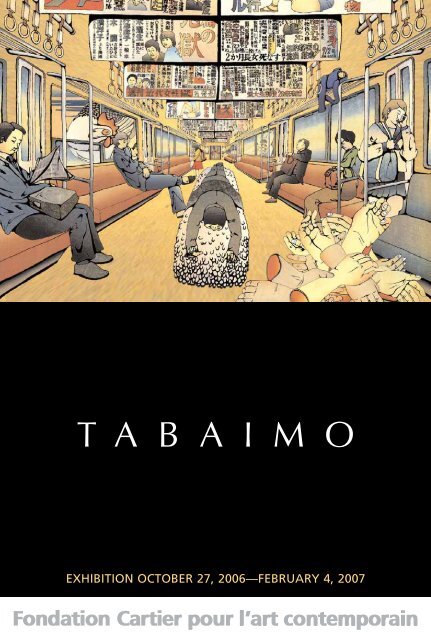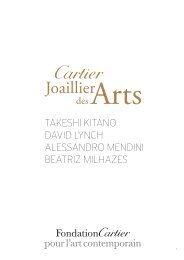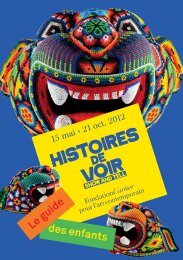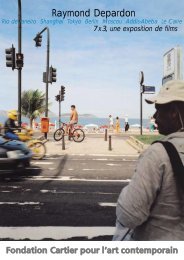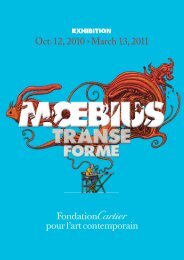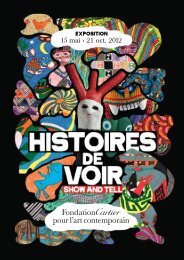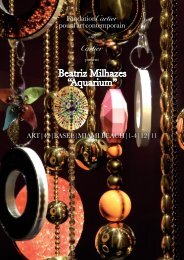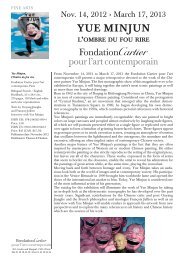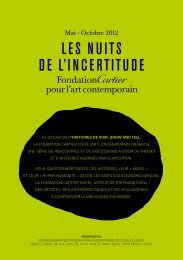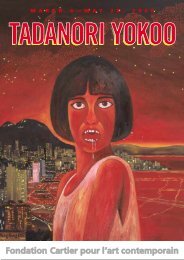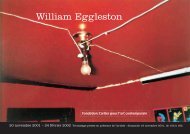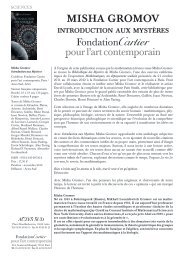Download - Fondation Cartier pour l'art contemporain - Cartier
Download - Fondation Cartier pour l'art contemporain - Cartier
Download - Fondation Cartier pour l'art contemporain - Cartier
You also want an ePaper? Increase the reach of your titles
YUMPU automatically turns print PDFs into web optimized ePapers that Google loves.
T A B A I M O<br />
EXHIBITION OCTOBER 27, 2006—FEBRUARY 4, 2007
© Tabaimo, courtesy Gallery Koyanagi, Tokyo<br />
THE FONDATION CARTIER POUR L’ART CONTEMPORAIN PRESENTS, FOR THE FIRST<br />
TIME IN EUROPE, THE WORK OF JAPANESE ARTIST TABAIMO, A RISING STAR IN<br />
ANIMATION AND VIDEO ART. BREAKING AWAY FROM THE PREVAILING AESTHETIC<br />
OF ANIME IN JAPAN, TABAIMO’S CREATIONS ARE INSPIRED BY HER OBSERVATION<br />
OF MODERN CITY LIFE, BUT BORROW THEIR NUANCED HUES FROM TRADI-<br />
TIONAL JAPANESE PRINTS. THE THREE VIDEO INSTALLATIONS PRESENTED AT THE<br />
FONDATION CARTIER PLUNGE VIEW-<br />
ERS INTO A WORLD THAT IS BOTH<br />
ALLURING, INFINITELY TROUBLING,<br />
AND REVEALING OF PRESENT-DAY<br />
JAPAN’S DARK SIDE.<br />
TABAIMO<br />
Large Gallery<br />
Japanese Commuter Train, 2001<br />
Video installation, 8’ (looped)<br />
Projected across six screens, Japanese Commuter<br />
Train recreates the interior of a typical commuter<br />
train. In spite of an overall sense of calm, a series of<br />
incongruous events begins to take place inside the<br />
car—a schoolgirl is turned into sushi by a chef, the<br />
passengers’ arms fall off one by one, a woman flies<br />
out of the window—as the drowsy students and<br />
office workers look on impassively. Positioned in the<br />
middle of the installation, the viewer watches these<br />
semi-realistic, semi-phantasmagoric scenes while<br />
submerged in an uninterrupted flow of images and<br />
sounds.<br />
“In my opinion, only an uncomfortable environment<br />
will stimulate people like us to take initiative because<br />
we’re so accustomed to the passive nature of entertainment<br />
culture. My installations require some kind<br />
of participation to complete the story being told by<br />
the images that the viewer is watching. The enclosed,<br />
restricted spaces that I construct may provoke a feeling<br />
of oppression, physical confinement, or the loss<br />
of a sense of time. But in exchange, I hope that what<br />
viewers take away with them is a singular experience,<br />
one that is uniquely their own.”<br />
Passage from an interview with the artist<br />
published in the exhibition catalogue.
EXHIBITION OCTOBER 27, 2006—FEBRUARY 4, 2007<br />
Haunted House, 2003<br />
Video installation, 4’ (looped)<br />
A beam of light moving across a small dark room in a<br />
180-degree arc gradually reveals an urban landscape<br />
to the tune of electronic music playing in the background.<br />
The viewer, placed in the position of a voyeur,<br />
looks into the windows of buildings and observes<br />
everyday situations: a young girl in front of her<br />
computer screen, a family having dinner, a woman<br />
hanging up the laundry to dry. These scenes, however,<br />
quickly become disturbing and transform into tabloid<br />
anecdotes.<br />
“The media enters almost naturally into my environment<br />
on a daily basis, even when I don’t necessarily<br />
want to pay it any special attention. It is a basic part<br />
of my life, in exactly the same way as activities like<br />
eating and sleeping. Once events have been filtered<br />
by the media, they are turned into simple news items<br />
and stripped of any emotive charge. We receive them<br />
as such, even though they’re very serious incidents<br />
that would be extraordinarily upsetting if they were<br />
to happen to anyone we knew personally. This same<br />
process also happens with me; even though I exist<br />
here and now, the news items create a sense of unreality<br />
in me that I find very strange. My works consist<br />
of this sense of strangeness conveyed in various ways.<br />
I’m neither trying to describe the world as it exists,<br />
nor am I attempting to trigger a particular psychological<br />
response in the viewer. I simply wish to express<br />
the ‘me’ that appears in the mirror of the media.”<br />
Passage from an interview with the artist<br />
published in the exhibition catalogue.<br />
Small Gallery<br />
midnight sea, 2006<br />
Video installation, 4’ (looped)<br />
By setting up a micro-structure inside the exhibition<br />
space, Tabaimo creates an environment that is both<br />
mental and physical for midnight sea. Stylized wave<br />
motifs, undulating movements, and the sounds of<br />
surf and water are interwoven into a black-andwhite<br />
seascape. The artist invites visitors to “go with<br />
the flow” of this dreamlike reverie whose purified<br />
aesthetic is sown with traditional references.<br />
“The sea uses the meaningful movement of its waves<br />
to conceal the depths of its transparent waters. It stirs<br />
up these mysterious, elusive undulations, like living<br />
creatures, to display them before our eyes, increasing<br />
our fascination for its abyss.<br />
Waves are sometimes compared to wrinkles on the<br />
skin, and vice versa, which seems to act as proof of a<br />
close relationship between these two words. [The]<br />
age-old Japanese tradition of linking the human body<br />
to the sea is deeply ingrained in my consciousness.”<br />
Passages from the exhibition catalogue.
Biography<br />
Born in Hyogo in 1975, the young Ayako Tabata was<br />
nicknamed Tabaimo—meaning “Tabata’s little<br />
sister”—by a friend. In 1999, she created her first<br />
video works, immediately drawing attention to the<br />
23-year-old artist and winning her the prestigious<br />
Kirin Contemporary Award. Japanese Kitchen (1999),<br />
her breakthrough work, displayed her country’s social<br />
and economic problems in a video installation that<br />
established her style from the outset: animated films<br />
that combine drawings evoking the “hand-made”<br />
quality of traditional Japanese wood prints with<br />
sophisticated computer technology. In 2001, she was<br />
the youngest artist invited to participate in the<br />
Yokohama Triennale. Her work was then shown internationally<br />
in the Netherlands, Belgium, and the UK,<br />
as well as at the 2002 São Paulo Biennale and the<br />
2006 Sydney Biennale. Her exhibition at the <strong>Fondation</strong><br />
<strong>Cartier</strong> <strong>pour</strong> l’art <strong>contemporain</strong> is her first solo show<br />
in Europe.<br />
Solo exhibitions<br />
2006<br />
Tabaimo, <strong>Fondation</strong> <strong>Cartier</strong> <strong>pour</strong> l’art <strong>contemporain</strong>, Paris<br />
YOROYORON Tabaimo, Hara Museum<br />
of Contemporary Art, Tokyo<br />
in the Kitchen, Takahashi Collection, Tokyo<br />
2005<br />
yubibira, Gallery Koyanagi, Tokyo<br />
TABAIMO, James Cohan Gallery, New York<br />
2003<br />
Haunted House,<br />
The Hall, Hara Museum of Contemporary Art, Tokyo<br />
New Print Work,<br />
Hiromi Yoshi + Gallery Koyanagi Viewing Room, Tokyo<br />
Japanese Little Kitchen, Gallery Koyanagi, Tokyo<br />
TABAIMO—yumechigae, Hara Museum ARC, Gunma<br />
Tabaimo: ODORO ODORO,<br />
Tokyo Opera City Art Gallery, Tokyo<br />
Queta Queta of Tabaimo, yasu Gallery, Tokyo<br />
2002<br />
Tabaimo—The Japanese Interior IMA,<br />
Internet Museum of Art<br />
2001<br />
Tabaimo—The Japanese Bathhouse, Chapter, Cardiff<br />
2000<br />
Kirin Contemporary Award 1999: Grand prize<br />
Commemoration Exhibition, Kirin Plaza Osaka, Osaka<br />
Japanese Zebra Crossing, galerie 16, Kyoto<br />
1999<br />
Japanese Kitchen Tabaimo, “Cubic” gallery Ïteza, Kyoto<br />
Awards<br />
2005<br />
12th Award to a Promising Artist and Scholar in the Field<br />
of Contemporary Japanese Arts<br />
2004<br />
23rd Kyoto Prefecture Culture Prize, Incentive Prize<br />
2002<br />
The Gotoh Memorial Prize, New Face Award (Art Category)<br />
2001<br />
12th Sakuya-konohana Prize (Art Category)<br />
1999<br />
BBCC Net Art & Film Festival 1999,<br />
Grand Prize (Film Category)<br />
Kirin Contemporary Award 1999, Grand Prize<br />
Kyoto University of Art and Design<br />
Graduation Works Exhibition, President Prize<br />
Bibliography<br />
Tabaimo, <strong>Fondation</strong> <strong>Cartier</strong> <strong>pour</strong> l’art <strong>contemporain</strong>, Paris,<br />
2006 (bilingual French/English).<br />
YOROYORON Tabaimo, Hara Museum of Contemporary<br />
Art, Tokyo, 2006 (bilingual Japanese/English).<br />
TABAIMO—yumechigae, Hara Museum of Contemporary<br />
Art, Tokyo, 2003. Text by Yukari OKADA (bilingual<br />
Japanese/English).<br />
Tabaimo: ODORO ODORO, Tokyo Opera City Art Gallery,<br />
Tokyo, 2003. Text by Hisako HARA (bilingual<br />
Japanese/ English).<br />
Exhibition catalog<br />
Tabaimo<br />
<strong>Fondation</strong> <strong>Cartier</strong> <strong>pour</strong> l’art <strong>contemporain</strong>, Paris/<br />
Thames and Hudson, London-New York<br />
Hardback, bilingual French/English<br />
20.5 x 28 cm, 96 pages, 70 color illustrations<br />
Interview with Tabaimo<br />
Presentation of works by the artist<br />
Price: 28 €
Upcoming Exhibitions<br />
David Lynch, The Air is on Fire March 3 – June 3, 2007<br />
David Lynch will present his work as an artist in an unparalleled exhibition event that explores the filmmaker’s<br />
prolific and diverse practice as a painter, photographer, filmmaker, sculptor, and sound artist. The Air is on Fire<br />
will feature works created specially for the occasion and will occupy the <strong>Fondation</strong> <strong>Cartier</strong>’s entire exhibition<br />
space in a setting designed with David Lynch’s close involvement. A reference catalog published in both<br />
English and French will accompany the exhibition and explore the ensemble of the artist’s oeuvre.<br />
Raymond Depardon in Berlin February 7—April 1, 2007<br />
The <strong>Fondation</strong> <strong>Cartier</strong> will be present on the European scene with the exhibition Raymond Depardon, on view<br />
at the Museum für Fotografie in Berlin. This project will bring together a series of 7 films on Rio de Janeiro,<br />
Tokyo, Berlin, Moscow, Shanghai, Addis Ababa and Cairo, which were first presented in 2004 at the<br />
<strong>Fondation</strong> <strong>Cartier</strong> <strong>pour</strong> l’art <strong>contemporain</strong>. In addition to these works, Raymond Depardon will also present<br />
5 new films on Buenos Aires, Paris, New York, Johannesburg and Dubai, realized specifically for the Berlin<br />
exhibition. At the request of the <strong>Fondation</strong> <strong>Cartier</strong>, Raymond Depardon spent 3 days in each of these cities in<br />
order to make a short film about each, as well as a series of photographs, also on view. This exhibition will<br />
provide the German public with an opportunity to discover one of the most important French filmmakers and<br />
photographers active today.<br />
Press Information<br />
Linda Chenit<br />
assisted by Hélène Cahuzac<br />
tel +33 (0)1 42 18 56 77/65 fax +33 (0)1 42 18 56 52<br />
linda.chenit@fondation.cartier.com<br />
images on line: fondation.cartier.com<br />
General Information<br />
The <strong>Fondation</strong> <strong>Cartier</strong> <strong>pour</strong> l’art <strong>contemporain</strong> is open to the public every day except Monday,<br />
from 12 p.m. to 8 p.m.<br />
Entrance fee: 6.50 €, reduced rate*: 4.50 €<br />
“Circle of Friends” annual pass: 38 €**<br />
Nomadic Nights<br />
Thursday evenings at 8:30 p.m. (except special evenings)<br />
Information and reservations (imperative), every day, except Monday, from 12 p.m. to 8 p.m.:<br />
tel + 33 (0)1 42 18 56 72<br />
Entrance fee: 8 €, reduced rate*: 6.50 €<br />
Educational Activities<br />
Lecture series, activities for children, guided tours and group visits<br />
Information and reservations: tel +33 (0)1 42 18 56 67<br />
For our complete agenda, please visit fondation.cartier.com (“What’s on” section)<br />
Access<br />
261, boulevard Raspail 75014 Paris tel +33 (0)1 42 18 56 50 fax +33 (0)1 42 18 56 52<br />
métro Raspail or Denfert-Rochereau – Bus 38, 68, 88, 91 – RER B: Denfert-Rochereau<br />
fondation.cartier.com<br />
*students, individuals under 25, carte Senior, Amis des Musées, unemployed. Free admission: “Circle of Friends,” individuals under 10, ICOM<br />
**students/seniors rate: 25 €, duo rate: 58 €<br />
The Gary Hill and Tabaimo exhibitions were organized with the support of the <strong>Fondation</strong> <strong>Cartier</strong> <strong>pour</strong> <strong>l'art</strong> <strong>contemporain</strong>,<br />
under the aegis of the <strong>Fondation</strong> de France and with the sponsorship of <strong>Cartier</strong>.


